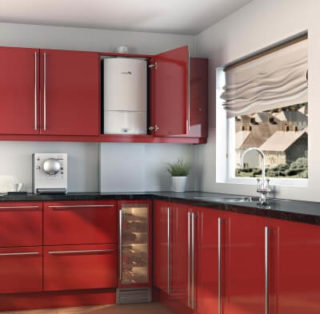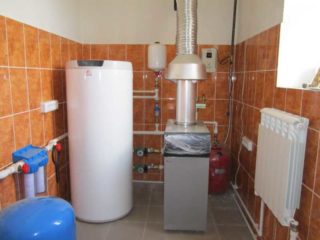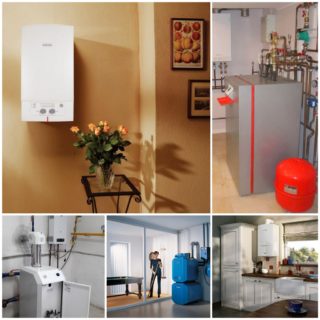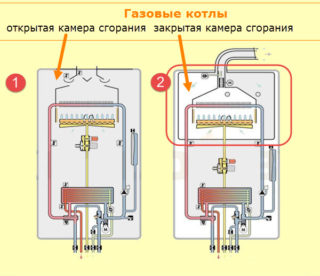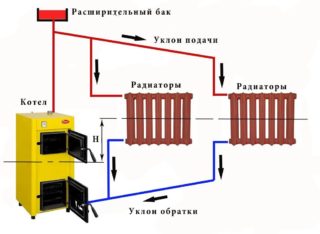Gas heating boiler - a device for heating a room using natural gas as a fuel. With the help of a burner, fuel is converted into heat energy and transferred to the coolant - most often water. Heated liquid flows through pipes into radiators and thus heats an apartment, a private house, utility rooms.
The device of gas boilers
The design of a conventional gas boiler includes the following elements:
- Gas burner with nozzles through which gas is supplied for combustion. Thanks to the nozzles, fuel is distributed evenly and is used more economically.
- A heat exchanger is a metal box, inside of which pipes with a circulating coolant pass. The incoming chilled fluid from the radiators heats up again and moves back. Depending on the design, the heat exchanger can be one or two. In simple boilers, the heating is temporarily turned off during water heating.
- Circulation pump. Serves for forced transportation of fluid through pipes.
- An expansion tank is needed to temporarily bleed fluid that expands when heated.
- Mechanisms for removing gas combustion products. In atmospheric-type boilers, the device joins the chimney. In turbo boilers, combustion products are discharged through a pipe through a fan.
- Electronic board - boiler control unit. Monitors the set equipment settings using the data of the built-in sensors.
- Pressure gauge for monitoring the pressure in the system.
- The display, which reflects the performance of the equipment.
Depending on the design, each element may have various modifications that affect the cost and service life of the product. For example, a cast-iron heat exchanger is considered the most reliable, and a layer of copper is applied to a steel one to extend its service life.
Gas boiler with different connection outputs
The purpose of installing single-circuit and double-circuit gas boilers is different. If the house or apartment already has one heating element that heats the water, the boiler can only be used for heating purposes. If there are no such devices, you need to choose dual-circuit equipment that can switch from the heating function to the heating of water for domestic needs.
Single-circuit
The disadvantage of a single-circuit boiler is the need to purchase another expensive device - a water boiler. The cost of two units is more expensive than one double-circuit boiler. If the power of one device is not enough, for example, in the presence of an extension, the boiler / boiler option is justified.
Bypass
Dual-circuit equipment is capable of performing the functions of a boiler and a heating boiler at the same time. At the same time, the design of the boilers is more complicated. Differences may be:
- In the heat exchanger circuit - bithermic or double separate. In the first case, water for domestic hot water flows along one route, and for heating along another. With a double heat exchanger, each device controls its volume of liquid.
- In the presence or absence of a built-in boiler, up to 60 liters.
When buying a gas boiler, you need to know that some of them can only heat water during the heating season, when the burner is constantly on. In summer, the unit does not produce hot water. Such models are cheaper and are designed for the fact that the house already has a boiler.
Double-circuit boilers are distinguished by the presence of a three-way valve, which changes the direction of the liquid either for heating or for heating for domestic purposes.
Design Features
Depending on the installation method, gas boiler models can be floor and wall. Some are suitable for private houses, it is desirable to place them in a specially equipped boiler room, where there is enough space. Others are designed for operation in the apartment and are mounted on the walls.
Floor
Power of floor units from 10 to 100 kW. Instrument weight up to 100 kg. Most often they have cast-iron parts inside. Floor models are considered more reliable, since they are less dependent on electronics. They are single-circuit and double-circuit.
Wall mounted
Wall equipment is less heavy and more compact than floor equipment. To safely stay on the wall, the weight of the product should not exceed 50 kg. They are produced for apartments, therefore more often they are produced by double-circuit. They take up less space, as additional elements are already built into the boiler.
The advantage of wall mounted models is easier installation. You don’t need a chimney for them - just install the boiler on a wall that faces the street, punch a hole and remove the pipe.
The disadvantage of wall mounted models is lower power compared to floor units. Usually for an apartment or a small-sized house there is enough power in excess. 1 kW is able to heat 10 square meters of space.
The combustion chamber
When buying a gas boiler for heating a private house or apartment, the capacity, installation method and number of circuits are evaluated. But there is another important parameter - the combustion chamber. It can be open or closed.
Open
With the combustion chamber open, air enters the burner from the room. Benefits:
- no duct needed;
- installation of such equipment is simpler;
- relative non-volatility - if the unit does not have a complex electronic control system, the voltage does not particularly affect the efficiency of work;
- lower cost compared to boilers with a closed combustion chamber.
The negative sides of the open camera:
- the need for constant ventilation of the room from which the device takes oxygen;
- the operation of the boiler affects humidity - the air in the room is drier;
- Do-it-yourself installation of the chimney carries a fraction of the risk, since with poor sealing, carbon monoxide will begin to flow into the room.
It will be necessary to clean the internal parts more often, since a unit with an open combustion chamber draws in dust along with air.
Closed
The principle of air circulation in boilers with a closed combustion chamber is different. Air is pumped from the street using the built-in fan. During combustion, residual products also come out due to forced extraction.
The advantage of a closed combustion chamber:
- There are no installation restrictions.
- They can be placed safely in the kitchen.
- Existence of filters for street air so that internal details are not clogged.
The disadvantage of this type of design:
- The need to equip two channels - for air supply and removal of combustion products.
- The fan stops if power is lost. It is not possible to exhaust smoke without a fan.
- Boilers with a closed chamber are much more expensive.
Typically, a coaxial chimney is connected to gas boilers of this type. Its essence is in the installation of two pipes located one in the other - air is drawn in on the inside, and combustion products are taken out on the outside. Using a coaxial type chimney, gas can be saved by heating the air masses with exhaust smoke.
The location of the coaxial pipes eliminates the leakage of carbon monoxide, therefore, the boiler works safer.The chimney can be done by yourself according to the manufacturer's instructions.
Boiler exhaust system device
The device of the exhaust system in a private house can be divided into 3 types:
- By the method of air supply - with forced or natural circulation. In the first case, a fan is installed, in the second, air masses enter through windows and doors.
- For the intended purpose - exhaust, mixed type and supply. The exhaust gives the exhaust air mass to the ventilation shaft. The supply system removes gases, pushing them out with a stream of clean air, sucked into the room by a fan. The design of the mixed type has elements of the exhaust and supply systems - a supply fan and a ventilation shaft for exhaust gases.
- By design. This is a channel and channelless ventilation system.
The choice of exhaust system for a gas boiler depends on the presence of a chimney or ventilation. In old houses, all work has to be done at the stage of installation of equipment. If metal-plastic windows are installed or planned in the house, it is not necessary to rely on natural circulation, since the tightness of plastic windows does not imply the ingress of fresh air through the windows. In summer, the natural circulation of air masses is impossible, since the principle of its operation is based on the temperature difference inside and out. The best option is a supply or mixed exhaust system. A mixed system with a ventilation shaft and a suction fan works best.
The volatility of gas boilers
Volatile gas boilers make up the majority of models manufactured for equipment consumers. Among them are floor and wall. Volatile boilers consume less fuel, as they have built-in temperature sensors, reducing the amount of gas consumed. Energy is consumed by the electronic circuit board and the circulation pump.
The downside is the additional costs and the availability of a fee, which in case of failure is expensive to repair. To avoid power surges, it is recommended to install a stabilizer - for some manufacturers this point is crucial for warranty repairs.
Autonomous systems
Non-volatile produce most models of the floor type. An important condition for the installation of such equipment is its location at the lowest point of the room - usually the basement or basement. Water circulation occurs when it is heated.
A distinctive feature is the open combustion chamber - this helps to increase traction for the removal of toxic waste from the gas combustion process. There is a reverse draft sensor to turn off the equipment in case of insufficient operation of the exhaust system. There are two burners in non-volatile boilers - for fuse and main.
All the disadvantages of the autonomous system are manifested when the design is incorrect, so installation should be entrusted to professional gas workers who also have equipment for measuring the carbon monoxide level of operating equipment. Carbon monoxide is odorless, therefore doubly dangerous.
Selection criteria for a private home
The choice of a gas boiler comes from several calculations:
- How many people live in the house. This will determine how much water needs to be heated per day to service all residents, if the boiler is planned to be double-circuit. To provide water for one person, a model with a built-in boiler is suitable.
- The area of the heated room. On average, for heating 10 square meters. m requires 1 kW of energy.This figure increases significantly if the ceiling, walls, floor are not insulated in the house, old wooden windows are installed - most of the heat will go up and dissolve in the cold masses located above the ceiling.
- A non-volatile model is chosen if it is possible to mount the boiler at a low point, for example, an equipped basement. For apartment heating, such equipment is not suitable. Its operation is associated with increased risks.
- Often, apartment models are chosen for a private house, which does not affect the quality of heating.
The difference between boilers for a private house and an apartment is insignificant, therefore wall-mounted models can be successfully installed in houses and cottages.
The instruments of European manufacturers - Bosch, Grandini, Vilent, Wiesmann, Baxi, Proterm - have proven themselves best. Companies produce a large assortment, designed for different areas of the premises, as well as various operating conditions - with or without a stationary chimney.
Before switching on the boiler, it is recommended that you familiarize yourself with the operating conditions of the equipment indicated in the instructions. This will prevent breakdowns and costly repairs. It is also necessary to study the conditions of warranty service so that there are no mutual claims with representatives of a service center serving boilers.
